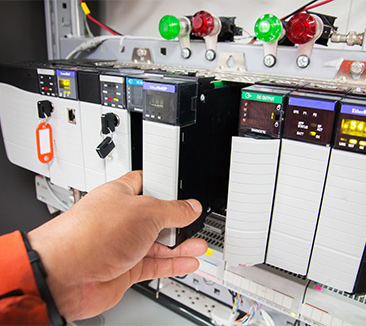PLC Vs PC- Which Should You Use?
Post By: Luke West On: 14-08-2023 Read Time: 4 minutes - Guides
Post By: Luke West On: 14-08-2023 Read Time: 4 minutes - Guides
New automation mechanisms such as programmable logic controllers (PLCs) in the 1970s made it possible to complete factory tasks in less time and with more precision. Automation revolutionised the factory floor, reducing the amount of human capital required, cutting down costs and making it easier for staff to manage systems.
As industrial automation has progressed, manufacturers have had more choice in the type of systems they use. The following article compares PLCs and industrial computers (PCs) to identify their advantages and differences, so you can decide which is best for your needs.
PLCs work by using input/output modules (I/O modules) with a central processing unit (CPU). The inputs are designed to accept analogue and digital signals from various sensors and field devices and convert them into logic signals that are compatible with the CPU. Once the CPU receives the signals, it executes control instructions according to the programming stored in its memory.
Prior to the introduction of PLCs in automation, relay panels and switch boxes were used to operate industrial tasks. They relied more heavily on electrical wiring and diagrams, making the process more complex. For this reason, PLCs and PCs have redefined how tasks are managed because changes no longer require extensive rerouting or rewiring.
PLCs are typically bulky and have limited mounting capabilities because they’re sensitive to overheating if their heat dissipation is obstructed.
PLCs function by monitoring instructions in real-time from other devices and then responding to the requests they receive, according to their programming. Their operating systems (OS) are designed exclusively for control tasks, meaning they operate with limited functions. PLC devices have a rugged design that can withstand extreme conditions such as electromagnetic radiation, vibrations and contamination.
Advancements in computers meant that they could be adapted for use in an industrial setting. Designed for the harsh conditions of a factory environment, PCs can carry out the same functions as PLCs, but with more functionality. For instance, they have human-machine interface (HMI) capability – a dashboard that allows a person to control a machine.
Industrial PCs are smaller, providing for different mount options such as VESA mount, din rail and rack options. Unlike regular PCs, they are designed for the harsh factory environment. For instance, they have a fanless design so particles don’t get stuck in the system and they are shock-resistant. Their design can also sustain the fluctuation of temperatures in factory environments and maintain a high IP rating.

IP ratings measure the level of sealing in electrical enclosures against external contaminants such as dust particles, solids, and liquids.
Something to note about industrial PCs is that they are at more risk of cyberattacks because they run on Windows and Linux operating systems, which means they require strong antivirus and firewall systems to provide adequate defence against security breaches.
PLCs operate through a scan-based execution program using ladder logic (part of the IEC 61131-2 industrial control standard, which includes programmable controllers).
Ladder logic executes pre-programmed tasks, allowing the programming code to swiftly adapt to the task at hand. Both PLCs and PCs have COM ports and I/O capabilities to control and monitor tasks, but the difference with PLCs is the ports and I/O modules are in-built.
PCs on the other hand use event-driven software, and operate with programming languages such as C/C++ and .NET. Industrial PCs are equipped with expansion slots for integration, so they can sustain a higher I/O. They also have more COM ports, LAN, USB, and HDMI ports, so they can run more tasks than a PLC.
It’s possible to set up custom PLCs for more complex processes to expand on their single function. Legacy PLCs were more secure against cyberattacks, but as the industry has developed, manufacturers have faced cyber attacks. Newer PLCs have taken this into account and are designed with enhanced security features.
PCs are highly customisable with efficiency accelerators such as CPUs, GPUs and TPUs to perform complex computations for smart assembly lines. Security of PCs remains a concern as their accessible programming and well-known operating systems (Windows, Linux) make them susceptible to attacks.
With industrial PCs more at risk of cyberattacks, some models of PCs have trusted platform modules or (TPM) 2.0 built into the motherboard of the system. A TPM chip is a crypto-processor that encrypts data to protect it against online and offline attacks.
PLCs are more common in the automation industry, particularly for requirements with a strict set of instructions. Considering their legacy technology and durability, they are used for various purposes across different industries, including oil, wind, and production. They have various applications, from packaging machines to assembly lines.
PLCs are cost-effective for smaller projects because they are designed for a single dedicated function and can manage high-speed I/O. But they may prove more expensive for larger projects.
PCs are gaining demand in the automation industry for their integration capability and smaller size, which makes for better storage. PCs could be more efficient for large-scale and ongoing manufacturing because of their expansion utility and programming languages, but concerns remain around the security of their operating systems.
The introduction of PLCs was just the beginning for the changing landscape of automation. Industrial PCs are now able to provide more space-efficient, powerful solutions that rival legacy technology. PLCs are still used extensively in the industry, but their space requirements and customisation costs can be a limitation for some factory operators.
Industrial PCs have a higher up-front cost, but this balances out in the long run as they have more capacity for customisation. Which option an operator invests in will ultimately be determined by their needs and budget. The introduction of 4.0 tech also influences the technology manufacturers use, especially with many production facilities seeking to implement efficiency and energy-saving initiatives.